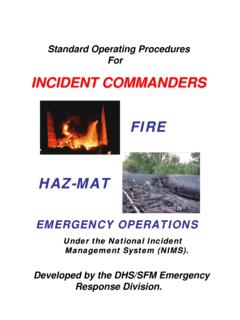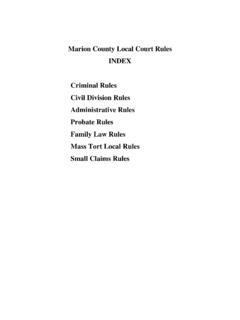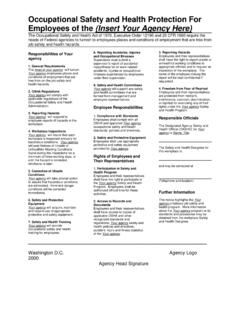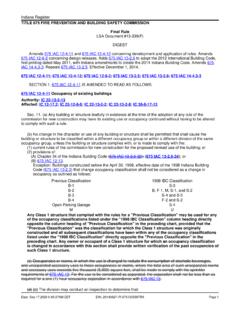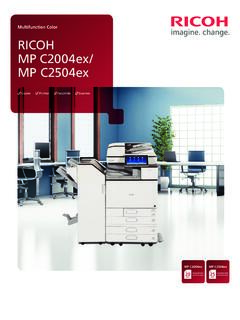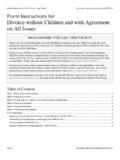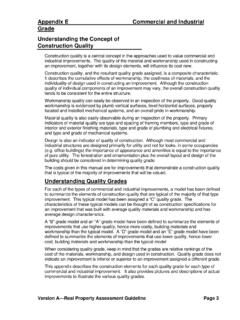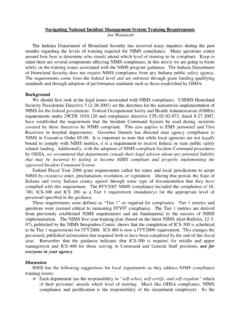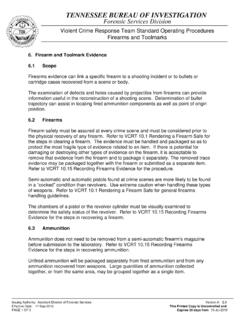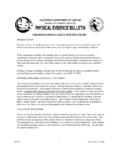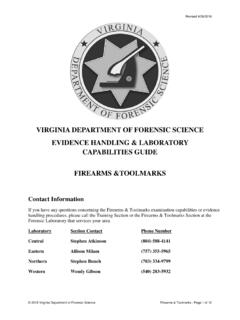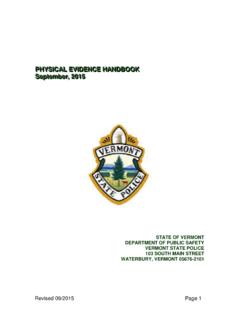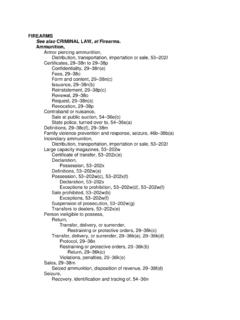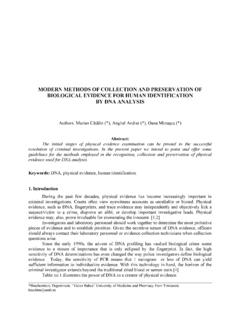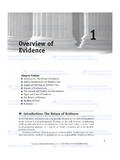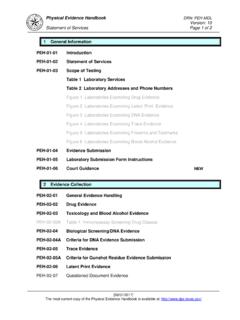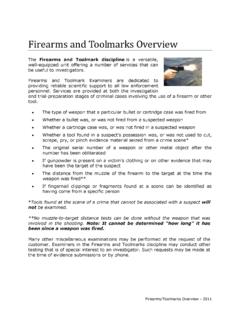Transcription of TEST METHODS - in.gov
1 Issuing Authority: Division Commander Page 1 of 109 Issue Date: 09/01/18 Version 19 Forensic Firearms Identification Unit TEST METHODS INDIANA STATE POLICE FORENSIC FIREARMS IDENTIFICATION UNIT TEST METHODS Issuing Authority: Division Commander Page 2 of 109 Issue Date: 09/01/18 Version 19 FOREWORD The Forensic Firearms Identification Unit (FFIU) of the Indiana State Police Laboratory Division is responsible for conducting forensic firearm and toolmark examinations, which relate to the examination of and comparative analysis of firearms, ammunition components, tools and the markings they produce. This service is provided to all law enforcement agencies, prosecutors, coroners and criminal justice agencies at no cost to the contributor. The FFIU is staffed with trained and skilled examiners who have baccalaureate degrees in criminal justice, physical sciences or other related studies. These examiners have successfully completed extensive formalized training programs under the direct control of the Laboratory Division and are directly supervised by the Forensic Firearms Identification Unit Supervisor.
2 During the training program, the new examiner shall successfully complete competency testing made up of written tests, oral examinations, and proficiency sample analyses. The body of knowledge which compromises forensic science is a compilation of procedures adapted from other disciplines that encompass many of the physical and natural sciences. During the history of forensic science, a multitude of individuals have greatly contributed to the protocols, METHODS and procedures that have become a routine part of analysis. All noted references contained in this document are a starting point and should not be considered an all-inclusive list. This document encompasses Firearms Examinations, Toolmark Examinations, Gunshot Residue Testing pertaining to distance, Serial Number Restorations, and NIBIN entries. This document supersedes all previous documents relating to these examinations and is subject to change according to research, study, and laboratory policy.
3 This test method document is a general approach to the examination of firearm and toolmark evidence and the results as they relate to these examinations. Alternative procedures , other than those listed, may be employed with the approval of the Unit Supervisor. INDIANA STATE POLICE FORENSIC FIREARMS IDENTIFICATION UNIT TEST METHODS Issuing Authority: Division Commander Page 3 of 109 Issue Date: 09/01/18 Version 19 TABLE OF CONTENTS 1. Physical Examination and Classification of Firearms METHODS Page 4 2. Safe firearm Handling Method Page 6 3. Trigger Pull METHODS Page 9 4. Barrel and Overall Length Measuring METHODS Page 12 5. Rusted firearm Method Page 16 6. Malfunctioning firearm Method Page 18 7. Automatic Firing Method Page 23 8. Bore/Chamber Casting Method Page 27 9. Test Firing METHODS Page 30 10. Caliber Determination METHODS Page 35 11. Ammunition Characterization METHODS Page 39 12.
4 Microscopic Comparison METHODS Page 45 13. Trace Examination METHODS Page 49 14. NIBIN Method Page 53 15. Range Determination Visual and Microscopic METHODS Page 56 16. Range Determination Chemical METHODS Page 59 17. Range Determination Test Pattern METHODS Page 66 18. Physical Examination and Classification of Tools and Toolmark MethodsPage 69 19. Toolmark Test Standards and Casting METHODS Page 72 20. Serial Number Restoration METHODS Page 75 APPENDICES: 1. Worksheets Page 81 2. Abbreviations Page 82 3. firearm Safety Page 83 4. Range of Conclusions Page 86 5. Firearms Reference collection Page 91 6. Ammunition Reference collection Page 94 7. Performance Checks and Maintenance Page 95 8. Verification of Casework Page 99 9. Hazardous Chemical Waste Management Page 101 10. Administrative and Technical Reviews Page 106 INDIANA STATE POLICE FORENSIC FIREARMS IDENTIFICATION UNIT TEST METHODS Issuing Authority: Division Commander Page 4 of 109 Issue Date: 09/01/18 Version 19 1.
5 PHYSICAL EXAMINATION AND CLASSIFICATION OF FIREARMS METHOD Scope: This method is used for the initial examination and classification of a firearm . Precautions/Limitations: The firearm examiner shall visually inspect the firearm to ensure that it is not loaded. If loaded, immediate steps shall be taken to ensure that the firearm is safely unloaded. Related Information: Safe firearm Handling Method 2 Worksheet Appendix 1 firearm Safety Appendix 3 Range of Conclusions Appendix 4 Firearms Reference collection Appendix 5 Instruments: None Reagents/Materials: None Hazards/Safety: This procedure involves materials, operations and equipment that may be hazardous. This procedure does not purport to address all of the safety problems associated with its use. It is the responsibility of the firearm examiner to establish appropriate safety and health practices and determine the applicability of regulatory limitations prior to use.
6 Proper caution shall be exercised and the use of personal protective equipment shall be considered. Proper caution to include strict adherence to Universal Precautions and the Blood Borne Pathogen Plan shall be exercised. Appropriate hearing and eye protection shall be worn when applicable. Reference Materials/Controls/Calibration Checks: None procedures /Instructions: Document the as-received condition of the seals of the evidence . Mark the outside of the original packaging with the case number, item number and examiners initials. Remove the firearm from the packaging and perform a 5 step safety check. A firearm worksheet may be filled out according to minimum standards and controls. This may include determining the following: Trace evidence Caliber/Gauge INDIANA STATE POLICE FORENSIC FIREARMS IDENTIFICATION UNIT TEST METHODS Issuing Authority: Division Commander Page 5 of 109 Issue Date: 09/01/18 Version 19 Make/Model Serial Number Firing mechanics Type of action Safeties Operating Condition Trigger Pull Rifling Characteristics Barrel length Overall length Any other data deemed relevant by the firearm examiner Records: The firearm examiner shall document their findings in the form of handwritten notes, computer generated notes, or by utilizing a firearms worksheet.
7 The examiner shall strictly adhere to all note taking procedures as prescribed by laboratory policy. Interpretations of Results: None Report Writing: Most firearm report writing can be found in the Range of Conclusions Appendix 4. However, it is noted that firearms occasionally are submitted inoperable or in very poor condition and these Range of Conclusions may not be pertinent. References: Association of Firearms and Toolmark Examiners Glossary, 6th Edition, Version Association of Firearms and Toolmark Examiners Training Manual, March 3, 2001 Association of Firearms and Toolmark Examiners procedures Manual, July 9, 2001 Guidelines for the Documentation of Firearms Examination , Scientific Working Group for Firearms and Toolmark Examiners, April 13, 2010 Technical Protocols for the Handling of Firearms and Ammunition , FBI, June 1992. INDIANA STATE POLICE FORENSIC FIREARMS IDENTIFICATION UNIT TEST METHODS Issuing Authority: Division Commander Page 6 of 109 Issue Date: 09/01/18 Version 19 2.
8 SAFE firearm HANDLING METHOD Scope: Firearms evidence in the laboratory environment is not dangerous if handled correctly and treated with respect. Occasionally, loaded firearms are received in evidence for a particular examination. These, of course, need very special handling. All firearms shall be treated as though they are loaded. This rule cannot be over stressed and shall be followed at all times, whether it is in the evidence receiving area, firearms section, test firing area or in court. Safe firearm handling within the laboratory environment corresponds with safe firearm handling in general. The only way to prevent accidents is to practice safety at all times. Precautions/Limitations: The firearm examiner shall visually inspect the firearm to ensure that it is not loaded. If loaded, immediate steps shall be taken to ensure that the firearm is safely unloaded. Related Information: Physical Examination and Classification of Firearms METHODS 1 Test Firing METHODS 9 Worksheet Appendix 1 firearm Safety Appendix 3 Range of Conclusions Appendix 4 Instruments: None Reagents/Materials: None Hazards/Safety: This procedure involves materials, operations and equipment that may be hazardous.
9 This procedure does not purport to address all of the safety problems associated with its use. It is the responsibility of the firearm examiner to establish appropriate safety and health practices and determine the applicability of regulatory limitations prior to use. Proper caution shall be exercised and the use of personal protective equipment shall be considered. Proper caution to include strict adherence to Universal Precautions and the Blood Borne Pathogen Plan shall be exercised. Appropriate hearing and eye protection shall be worn when applicable. Reference Materials/Controls/Calibration Checks: Indiana State Police Firearms Reference collection INDIANA STATE POLICE FORENSIC FIREARMS IDENTIFICATION UNIT TEST METHODS Issuing Authority: Division Commander Page 7 of 109 Issue Date: 09/01/18 Version 19 procedures /Instructions: The muzzle of the firearm shall always be pointed in a safe direction. Prior to any examination, regardless of which section is receiving the firearm , a competent individual shall ascertain the loaded or unloaded condition of the firearm .
10 If found to be loaded, the firearm shall be unloaded and rendered safe before any examination is to continue. Test firing or any examination of the firearm that utilizes live ammunition, or a live ammunition component, shall only be performed in designated test firing areas. A firearm shall not be placed in the evidence vault or returned to any agency in either a loaded condition or prior to its loaded or unloaded condition being checked. Some factors to consider when deciding whether or not a firearm can be safely test fired from the normal hand held position: Is the chamber/bore clear? Are there any signs of cracks or weaknesses in major parts of the firearm such as the frame, slide or barrel? Does the firearm function, lock-up or dry fire as you would expect it to? Is the correct ammunition being utilized? Some factors to consider when deciding if it is appropriate to utilize evidence ammunition: Are there signs of reloading?
